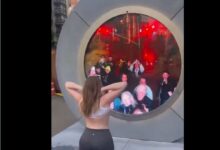Unveiling the Truth: The Markiplier TikTok Filter Leak?
On Batdongsancafef.vn – The digital world was set ablaze with the emergence of a TikTok filter purportedly showing Markiplier, a well-known YouTube influencer, in a … pose. This incident, encapsulated by the “Sraka Filter,” and often referred to as the “Markiplier Leak,” became a focal point for discussions on privacy, digital content authenticity, and the impact of viral media. This guide provides a comprehensive analysis of the event, tracing its origins, the public’s reaction, and its broader implications on digital culture and influencer privacy.
I. The Genesis of the Sraka Filter
The controversy began when a TikTok filter featuring an explicit image claimed to show Markiplier went viral under the name “Sraka Filter.” The filter, which cleverly used a “777” thematic element, was created by TikTok user @pilsudskidog and was part of a trend showcasing Rule 34 content—often involving sexually explicit material of popular figures. However, it was soon revealed that the image was a deepfake, a synthetic media where a person’s likeness is replaced with someone else’s image, often without consent.
II. Viral Spread and Public Reaction
Despite its short lifespan on TikTok, the filter achieved massive spread, prompting a myriad of user-generated content, including videos of reactions and memes. The digital community’s response was mixed; some expressed humor and fascination, while others were appalled by the potential privacy violations and ethical implications. These reactions underscored the varying levels of digital literacy and ethical considerations among internet users, as well as the unpredictable nature of viral internet culture.

III. Unpacking the Authenticity
Critical voices soon emerged, questioning the authenticity of the depicted image. Through collective sleuthing, internet users traced the image back to an AI-generated pornography account focused on creating deepfake content of celebrities. This discovery sparked a broader conversation about the ethics of AI in media creation, particularly the use of such technology to create realistic yet unconsented depictions of individuals.
IV. Markiplier’s Silence and Community Impact
Remarkably, Markiplier himself remained silent about the controversy, a decision that led to speculation and concern about the impact of such incidents on affected individuals. The event highlighted significant challenges in content moderation on platforms like TikTok and raised questions about the responsibility of platforms in preventing the spread of potentially harmful content. Furthermore, it underscored the vulnerability of public figures in the digital age, where their images and likenesses can be easily manipulated for viral content.

V. Ethical Considerations and Future Implications
The Markiplier TikTok filter leak serves as a potent example of the ethical quandaries posed by new media technologies. It challenges us to consider the boundaries of content creation and the protection of digital identities in an increasingly online world. As we move forward, the incident calls for enhanced strategies in digital ethics and literacy education, ensuring that users and creators alike understand the implications of their online actions and content.
@kizzomb1e HELP MEEE (pretty sure the filter is not real <the photo> so quit taking it so srs😭) #foryou #fyp #help #notfunny #fyppppppppppppppppppppppp #fypシ゚viral #fypツ
VI. Conclusion: Reflecting on Digital Identity and Ethics
The Markiplier leak not only entertained but also educated, serving as a critical case study in the interplay between technology, ethics, and privacy. It reminds us of the ongoing need for robust discussions and policies that address the complexities of digital content creation and consumption. As we navigate this ever-evolving digital landscape, the lessons learned from this incident will undoubtedly influence future discussions about the balance between innovation and ethical responsibility in the digital realm.








